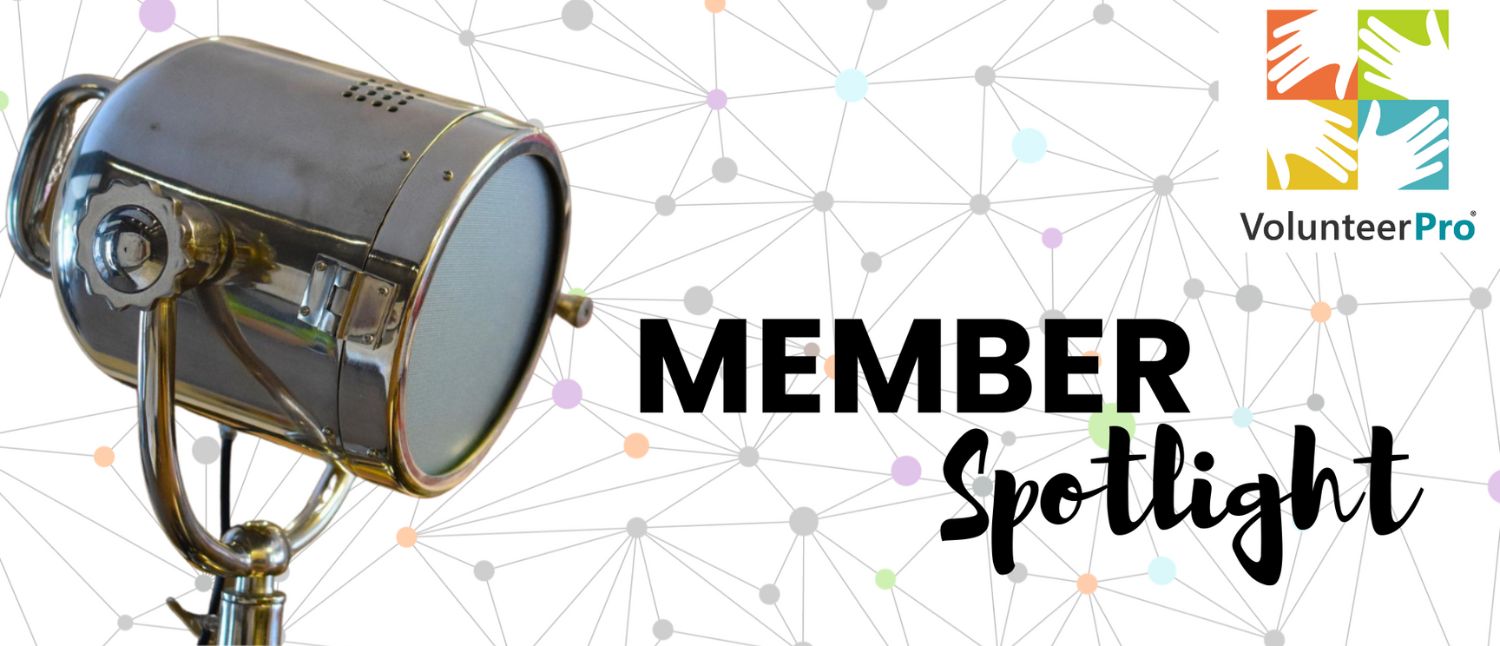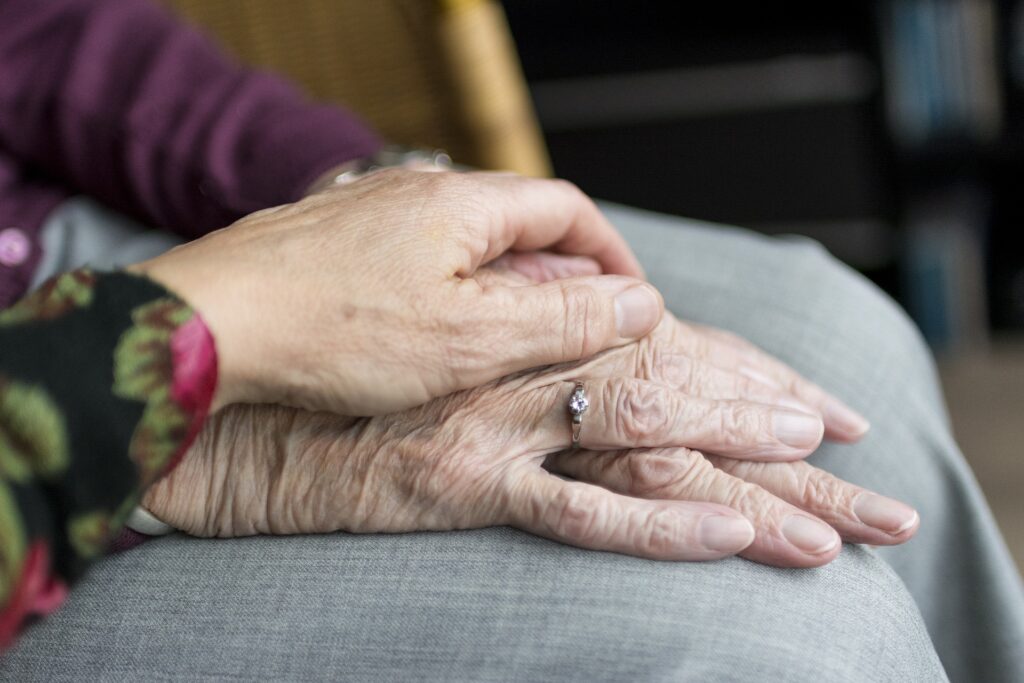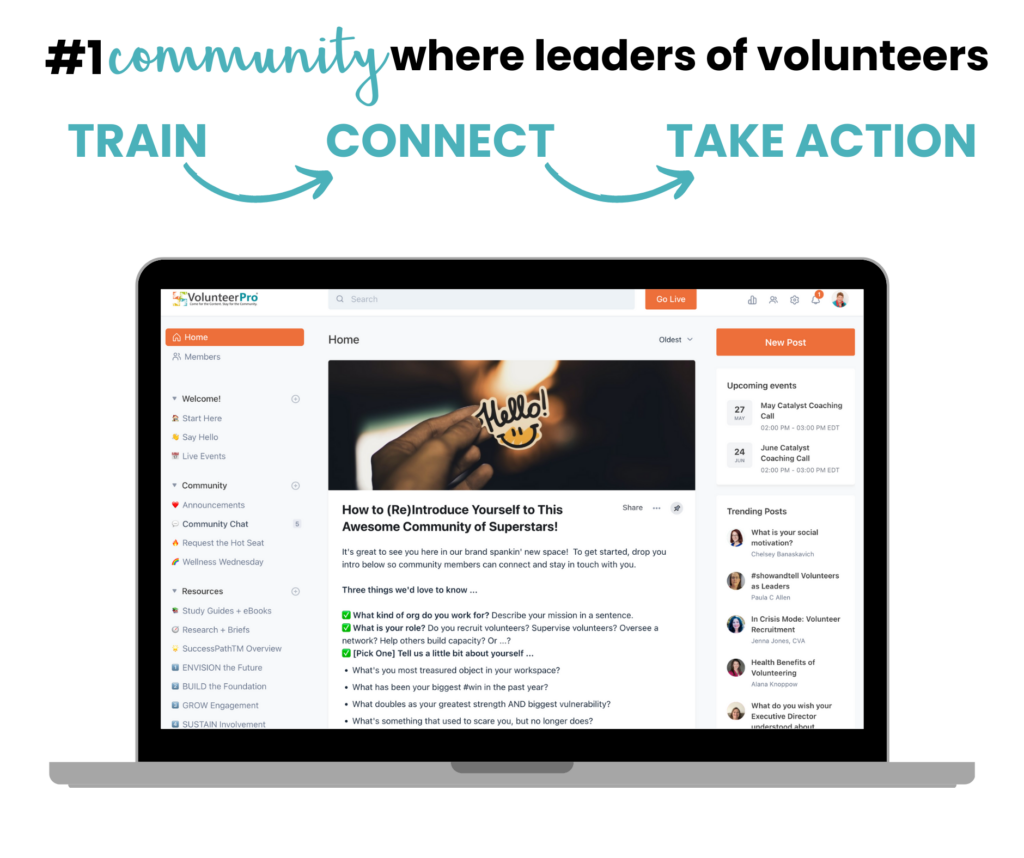Member Spotlight: Focusing on Community & Team
By engaging volunteers and asking key questions, Amanda Maragos, MHCM, CVRM, Director of Client Services and Volunteer Programs and her team at Phillip Aziz Centre for Hospice Care and Emily’s House Children’s Hospice have built a community that retains volunteers who are mobilized to serve. Amanda is joined by Chelsey, our VolunteerPro Community Manager, for this month’s member spotlight to chat about how her program created the community feel with a focus on volunteer care.
Chelsey: It’s great to see you, Amanda. Tell me about your organization.
Amanda: The name of my organization is Philip Aziz Centre for Hospice Care and Emily’s House Children’s Hospice. We are one organization, with two separate hospice palliative care programs.
The parent organization is Philip Aziz Centre, which is a community-based hospice program or otherwise known as an in-home hospice palliative care program. Our service providers go into the homes of clients and support those clients and their families at home or their setting of choice.
It might be in the hospital at that moment, or in their actual rooms. Maybe they’re in long-term care, but the largest population we have are people who have made the choice to be at home.
In our community program, we support all ages. We have a pediatric palliative care program called Emily’s House@Home, and we also support seniors, young adults, the elderly, and everybody in between.
Emily’s House Children’s Hospice is an extension of the children’s pediatric palliative care program in the form of a 10-bed inpatient hospice program. Emily’s House has an actual building with 10 beds, and we can support children and their families on site here.
These are families whose children are receiving their end-of-life care, but we also have a respite program, a transitional care program, and a symptom management program. There are different types of services that the children and their families can receive depending on which programs they are utilizing.
Chelsey: How did those two organizations come together?
Amanda: Essentially, one birthed the other. Philip Aziz Centre supported adults and children right from their beginnings.
Our CEO saw that there was a need for families to have hospice palliative care in an actual home, and an inpatient onsite location was established where children and their families could be supported through various programs.
These children and their families experience what it’s like to live with life-limiting illness all the time, and the life-limiting illnesses that those children are living with will eventually cause those children to die young. They’re typically illnesses where we don’t see those children living too far into their twenties.
Chelsey: I know when I think of hospice and end of life services, I think older or a million different things. I am embarrassed to admit, it never occurred to me that families with children need this type of support too. Why would that not occur to me?
Amanda: Well, because it totally upsets the order of things and the norm, you know? We don’t like to think about children dying. It’s kind of taboo to think about it, but guess what? Children die too and they die every day from illnesses.
One of the things that our organization does is provide education on what hospice palliative care looks like. There is a group of people out there in the world that do talk about end-of-life care and hospice, and that are interested in that subject – and those are our volunteers.
Chelsey: I know a little bit about hospice through a family member’s experience, and how nice it is to have people showing their love and support during a very difficult time. Tell me about your amazing volunteers.
Amanda: There are 14 volunteer roles at Philip Aziz Centre & Emily’s House. There is a client care in-person visiting program that provides direct psychosocial support to not only the clients, no matter how old they are, but also their family members and their siblings.
They become part of the care team because they support the family, not just the client. They are trained to provide psychosocial support. We make sure that they have an understanding of what, for instance, grief and bereavement support looks like.
We also train them about therapeutic encounters, active listening and what a therapeutic encounter looks like – not because they are expected to practice out of their scope, or to practice in any clinical way, but instead for them to have the ability to assess/flag when additional supports are needed and bring that information back to the team.
They are part of the multidisciplinary team that supports clients. The team that I manage is known as the allied health team. It includes client services and volunteer department staff because you really can’t have one without the other in hospice.
Our volunteers are still the largest population that supports our clients, and they work collaboratively with staff such as our children’s program coordinator, social worker, music therapist, nurses, PSWs, and grief and bereavement program coordinator.
Volunteers really have their hands in almost every single program. They even support the nurses as extra hands.
When we’re doing major projects and developing new programs or even doing quality improvements, we will involve volunteers in the process of informing those initiatives as frontline support workers. Volunteers definitely are the bloodline of our organization.
Chelsey: How do volunteers come to you?
Amanda: There is a population within our volunteer base that do hospice work because of their personal experience, whether it was a parent or a child, or another loved one.
Normally within that group they want to be involved because they saw what hospice services look like. Sometimes it’s the other way around and they wish the person they love would have had hospice services.
Some of them have a professional interest in end-of-life care or in social services or in healthcare. Or they have a personal interest for many reasons. Sometimes they work within a completely opposite sector, like finance or construction, but they have this desire and heart to help people.
They will tap into their own natural abilities and skills and, they do their own self-discovery of “where should I be?”. How do I want to give back to my community?
We also recruit volunteers through the Volunteer Toronto hub. Word of mouth is also a way we get applicants.
When we go out into the community and do an education session on what hospice palliative care is and who we are, we will naturally get people that will say, “Oh, I didn’t know that’s what hospice is. I didn’t know that’s what palliative care is. I didn’t know you guys existed. I would love to help in any way I can.” Then during that interview process we’ll find out exactly what the right role for them would be.
Chelsey: How did you get into the field of leading volunteers?
Amanda: I started off as a volunteer. I was in a very different profession that I did not find very fulfilling. I decided to do volunteer work and so I became a hospice volunteer. I did the training to work with adults and I did the paediatric hospice palliative care training as well.
I supported the organization as a volunteer for two years while I started my own business. I had started doing things that were fulfilling me and giving back to my community.
The Philip Aziz Centre had just started their capital campaign to raise funds to open Emily’s House when they asked me if I’d be interested in supporting their volunteer department one or two days a week with some administrative tasks. It was tough because as a paid staff member, I could no longer support the clients as a volunteer. I really thought about whether I wanted to give up my volunteer position for a paid one.
My faith played a part in my decision making. I thought about it, I prayed about it and knew I was here to help, and I’ll help in any way that they are asking.
My position grew over time, and I was assigned to develop the volunteer program for Emily’s House. I did a lot of research and I had to essentially just figure out what an onsite or inpatient paediatric-focused volunteer program looks like in hospice.
I didn’t have to start from scratch because we had the community program as a foundation. But there were definitely a lot of differences in an onsite setting versus in the community.
Now I’m the Director of Client Services and Volunteer Programs and we’ve got a much larger staff and volunteer team. I’ve been working and volunteering in hospice palliative care now since 2008, so about 15 years.
Chelsey: If you don’t mind me asking, how did you get connected with your organization as a volunteer?
Amanda: I actually learned about Philip Aziz Centre through the church I was attending. Philip Aziz Centre was actually birthed from that church (Church In The City in downtown Toronto).
Philip Aziz was a real man dying of an AIDS-related illness in the early nineties and was looking for support in his end-of-life care and found it at church. He had been rejected and stigmatized in other circles, but he found support there.
When he died, he bequeathed his estate to the church to start an organization that would offer people the same kind of unconditional love and support in their end-of-life journey that he had received. The church began the organization, but they no longer run the hospice.
All these years later I’m still attending the same church. Over the years, I always heard about the hospice that they support and members were also volunteers, but I didn’t exactly know what it was until I decided to onboard as a volunteer, even though I heard about it sometimes, I just felt like I was called to this work, and this is the place and that I was supposed to help.
Chelsey: I love that story. So many nonprofits have that kind of origin story. When someone realizes, “There’s nothing here for me” or ”I’ve been pushed away” and they’re like, “No, we’re going to find a way. We’re going make something that will help me and help others in the same situation.” So good!
What’s the biggest challenge that you’re facing right now in your program?
Amanda: The challenge right now would be deployment of volunteers. We’ve been able to retain our volunteers pretty well. But, retaining them and actually deploying them are two different things.
We had a really rough summer booking volunteers for on-site shifts at Emily’s House, or to take client matches in the community. I think now as people are feeling more comfortable with getting back out there and doing things within Toronto in general, they’re starting to book shifts again.
We revamped and strategized a communication plan to see how much we could really get people pumped and deployed for the fall. And so far, so good! It’s been working because people are starting to engage now. But as we are also in cold and flu season, we’re being very careful too. Deployment was our biggest challenge because we can help people feel part of a community and we can offer wellness and community interest events and do online programming for the volunteers, and of course we can onboard them and train them – but to deploy them, that is the challenge still
Learn more about engaging volunteers with these 12 Innovative Volunteer Engagement Strategies for the New “Normal” HERE>>
Chelsey: How did you engage your volunteers in this weird time?
Amanda: During COVID the way we retained our volunteers was not only to offer them a lot of wellness programming and give them opportunities to still feel part of a community (when they were feeling more isolated than ever before), but we also empowered them to be teachers and supporters of other volunteers (each other).
We kept this community together as much as we could. Now we are shifting the focus back to “we are ready for action” and back to doing what you were trained to do. Volunteers came for the community, but also for more than that.
We are offering education sessions so they can touch up on their skills too – because they could be feeling like, “Oh my goodness, I did my training like eight months ago. Am I ready to take on a client? Do I remember everything I learned?”
We make sure that there are refreshers offered, mentoring and even one-on-one support if they need it with their client. We really just made sure they didn’t feel alone as they were coming back on to serve.
Chelsey: How did you connect individually to get those volunteers to see where they need to be?
Amanda: We really had to let volunteers know what booking a shift would look like and that you wouldn’t be alone here. It was really a team effort.
It was never going to work if it was just the volunteer department doing it all. It had to be every staff person that that volunteer would be working with on site that would have to be part of making them feel comfortable and letting volunteers know what to expect ahead of time.
We wanted to let the volunteers know the benefits of coming back on site and that they wouldn’t be alone when they do.
Need a strategy? Create An Easy Volunteer Engagement Strategy in 6 Steps HERE>>
Chelsey: I’m interested to hear how your action shifted from engaging them, to moving them into coming in to volunteer.
Amanda: Well, we’ve been booking more volunteers in all the shift periods than we did in August. We had our family fall fair on site for the first time. It gave our volunteers different options and ways to get involved, and knowing that they’re supported the whole time.
That’s been a huge part of encouraging our volunteers. We did something called a campfire debrief in a space outside. We were able to have a fire pit, and we invited volunteers to come out for a debrief session. We did a little self-care check in, and then talked about what we want, how we want our relationship to be for the organization and the volunteer.
We said, “Oh, we’ll be lucky if we get about five people show up.” We had 14 volunteers show. It wasn’t too big a number, and people felt like it was a small enough group. It felt really close, and they bonded with each other.
Because we have roots in the HIV community as well, we also partnered with another organization. They were hosting a big fundraising event, and we asked how we could help. Their response: “Bring us volunteers!”
Sixteen of our volunteers showed up to help with that, too. We like that it’s not the same 14 volunteers doing everything. Everybody’s doing something that speaks to what they want to do right now.
Chelsey: I love that idea of helping other nonprofits with their needs. So often in my own history of leading volunteers, you’re so protective over your volunteers.
It’s so nice to be able to say, “What do you need?” And then deploy people to those areas and help out your fellow nonprofits that are doing similar things.
Amanda: I think it’s just our philosophy of volunteer care, which is banked off of one of the domains of practices in general that we do in hospice. There’s client-centered care as the top priority. It’s about the person, it’s about what their choices are, and what they want to do.
That’s what we do for our clients, and we take the same attitude with our staff and volunteers. Why are you here? What do you want to do? What is it that you’re looking for? What do you need? How do we make this experience yours?
Chelsey: What do you love most about your job?
Amanda: Definitely the people-work.
Chelsey: I was hoping you didn’t say “paperwork!“
Amanda: It’s interesting you say that, because in the moments where I feel like the administration is so heavy, I always remember and thank goodness I have an incredible staff team that I work with, and an incredible volunteer team to work alongside.
When I’m bogged down with all the administrative work, I always have this really great visual of the impact. I’m reminded that without these policies and procedures, the team can’t be awesome. It gives me a little extra fuel.
I also get to meet some really great, wonderful kiddos; it’s nice to go down there for a few minutes. Even just hearing the stories, like when the clients talk about how the services have impacted them, you realize it’s more than a trickle-down effect. It’s like a whole blood system, everything pumping through every part in the right way.
Chelsey: What’s one piece of advice you would give a new leader of volunteers?
Amanda: This might sound strange, but make sure you’re doing a gut check. Make sure you’re doing a self-check. Make sure you’re in it for the right reasons. Make sure you know why you’re there.
Self-reflect with an understanding that working with volunteers is going to require all kinds of formal and informal skills, attributes, and character traits that you have. I think a gut check is really important when you’re about to do this kind of work.
Also, get some sort of training so that you have a better understanding of volunteer management or coordination. A lot of people don’t know. And then they get in and they’re like, “Oh, I didn’t realize that volunteer management coordination is actually about four or five different jobs that each have their own titles, but they’re all part of this job.”
Volunteer management is not just one job. It’s usually about four or five worlds in one. I would also say make sure you know your scope of practice as a volunteer manager or coordinator, and then do a gut check, really self-reflect on whether it’s something that you want to do.
If you’re not a people person or you don’t like people management or if you don’t like doing administrative work, it’s not the job for you. If you have a hard time laying things out for people from steps one to five and supporting them in each of those steps with good communications, probably not for you if that’s not your thing.
Want to be a join a group of like-minded volunteer engagement professionals? You can in the VolunteerPro Membership HERE>>
Chelsey: How has being a member of VolunteerPro helped you?
Amanda: I think the biggest way VolunteerPro has helped me is with their resources. Sometimes when I’m stuck on one piece of something that I’m developing and I feel like I’m missing something, or I know there’s a better way for me to do this or say this, I definitely go on VolunteerPro and try to find the topic.
Other members comment about it on the forum, or I find an actual physical document Tobi has developed with top three things to think about. I’m like, “Number two, that’s the one I was. I got one, I got three, I understood that!” And then I’ll just be like,” Oh my gosh, that’s the piece I was missing. I was stuck on it. It’s that piece!”
The resources are just to affirm that I’m on the right track with an understanding they are general resources. I have to think very hospice-specific or program-specific on what’s works for me, but it’s just nice to have those resources to reference to either confirm, affirm, or to just help me get unstuck if I feel stuck for a moment.
Chelsey: What are you reading or watching right now?
Amanda: I’m a huge superhero fan, I was even before it was trendy to be one. I’m in the camp where you were a nerd if you liked superheroes.
I know now you don’t have to be a “nerd” to like superheroes. Everybody loves them now, but I come from a time where we were not the ones. I’ve been reading comic books since I was five years old, and I have my favorite characters.
There is a Sandman series on Netflix right now, and I have just gotten all the Sandman series comic books and am re-reading them before I watch the show. I’ve really enjoyed rereading them, because I was probably about 12 or 13 years old when I first read the Sandman series. Now I’m looking forward to the show. I also love fantasy and sci-fi.
Chelsey: It was so nice to chat with you Amanda. I loved hearing about your community approach with your volunteers and looking forward to hearing about all of your successes.
Join Us On the Inside as a VolunteerPro Member!
Join a great community of like-minded volunteer leaders as a VolunteerPro Member! VolPro membership helps you build or renovate an effective, what’s-working-now volunteer program with less stress and more joy, so you can ditch the overwhelm and confidently carry your vision forward.
It is the only implementation program of its kind and helps your organization build maturity across five phases of our proprietary system, the Volunteer Strategy Success PathTM.
Within membership, you’ll find in-depth training on how to build an effective recruitment and retention strategy, to attract and engage supporters in your good works. You’ll also have access to monthly coaching calls to ask questions and get feedback on your campaign design.
Membership includes access to a huge digital library of what-works-now content, live monthly seminars, workshops, and coaching calls, as well as a vibrant community of volunteer leaders to share ideas and questions.
Enrollment for new members is open NOW.












